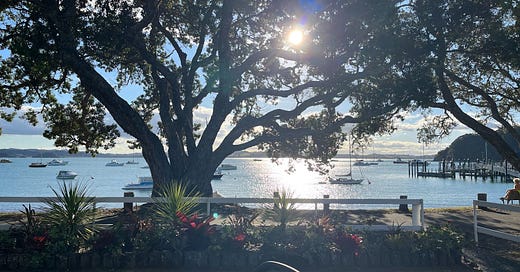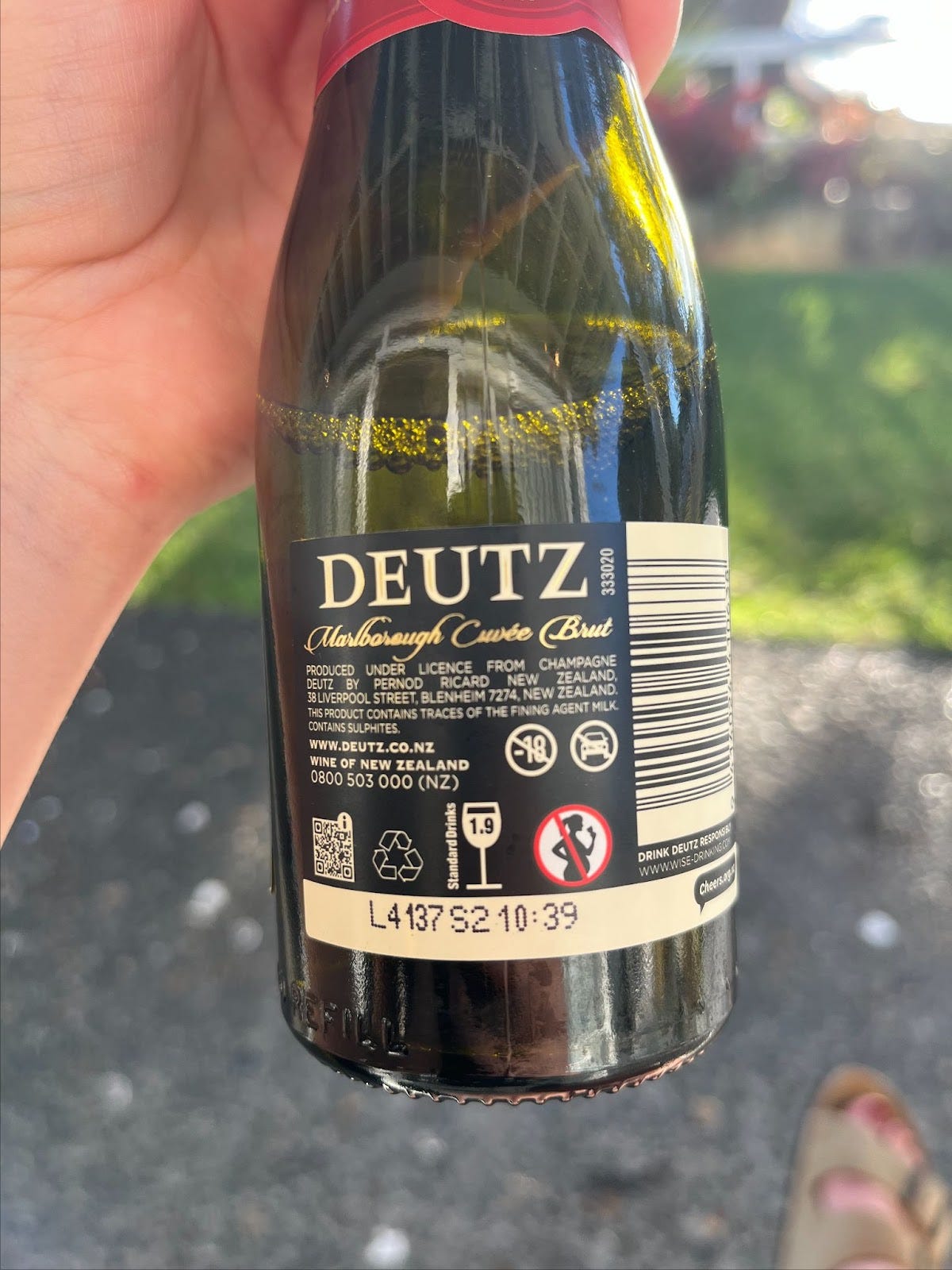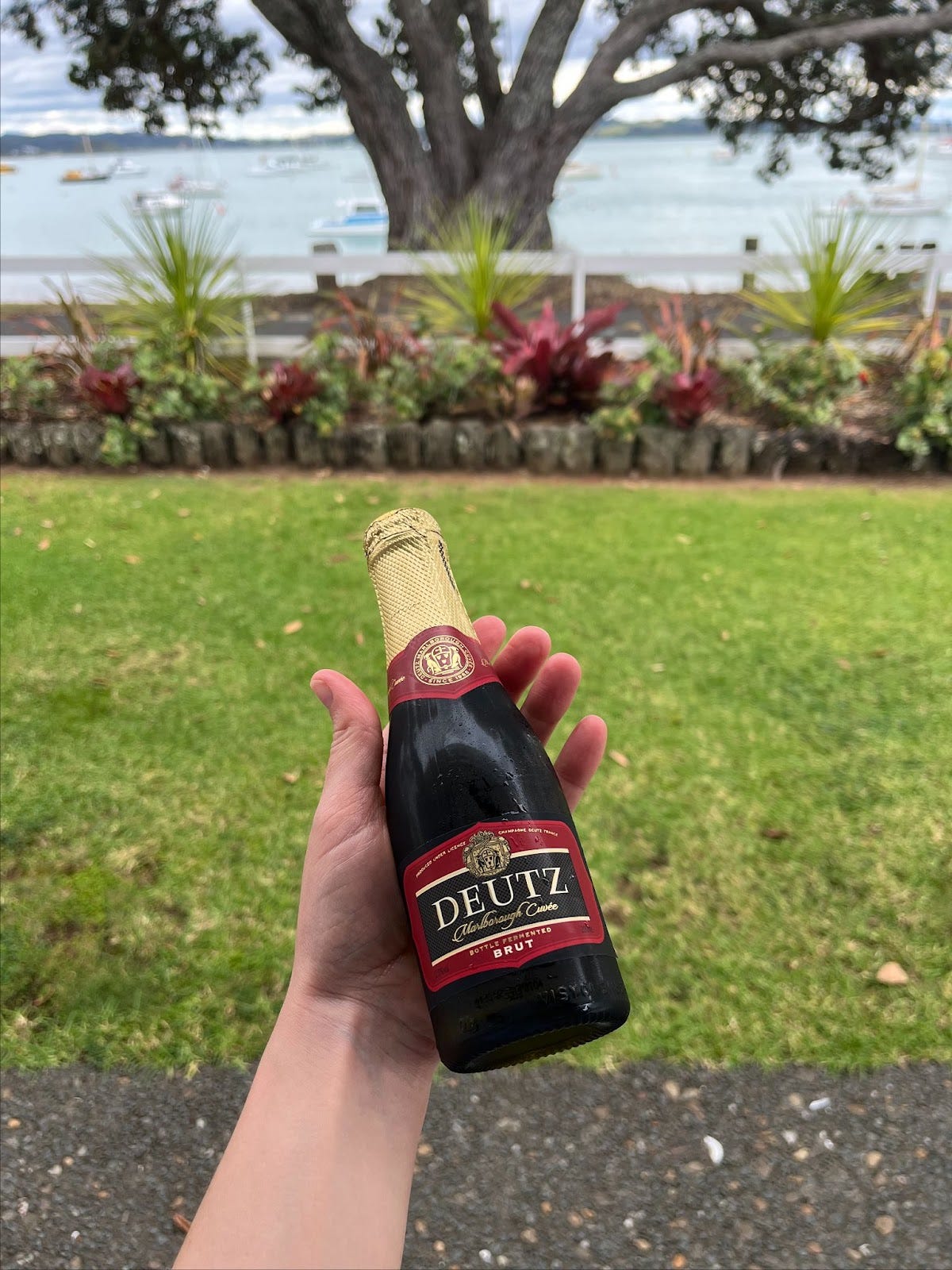During my trip to New Zealand, we found ourselves in Russell for a few days. Russell, a town in the Bay of Islands, is the real life equivalent of a Sylvanian village. Everything feels miniature. It’s a little toy town that has remained relatively quiet due to the fact that large cruise ships dock in nearby Paihia rather than its own quaint pier. Long Beach, conveniently located five minutes outside town, sums up New Zealand. Understated, naturally beautiful and friendly. It even has its own coffee cart where locals gather in the morning, with everyone appearing to know each other. I loved it here.
While I always try to drink local wine when abroad, Champagne is a wine that transcends borders. Nothing beats the pastry richness of Champagne, and I think holidays are improved by an impromptu bottle. I didn’t bring a bottle in my suitcase (I had to prioritise Formula over wine) so before I knew it I was in the local supermarket scanning the shelves. Like a collector in a record shop, I keep my eyes peeled for names I recognise at affordable price points.
We were a long way from France but a few of the big brands have a presence in New Zealand so I wasn’t surprised to see the likes of Moet and Veuve. However, I was surprised to see Deutz, a well-respected but lesser known Champagne producer in the sparkling section. What was even more unusual was the price. The other Champagnes were reassuringly expensive, factoring in the genuinely high price of Champagne and the export costs. So why was this Deutz so cheap?
Scratching my head, I took a closer look. In small writing on the front label I saw ‘Marlborough Cuvee Brut’. Ah! Here was the tell. This bottle was not made in Champagne. It was produced in New Zealand. Marlborough is arguably the country’s most prominent wine region, famous for Sauvignon Blanc but also for sparkling wines. Instead of buying a standard bottle, I spotted a tiny 200ml bottle (even smaller than the might half), which I couldn’t help buying. My curiosity came from the Deutz and Marlborough collaboration. What was the connection? What would it taste like?
This little bottle’s story starts with Pernod Ricard, a French company with its roots in Marseille (you’ll see everyone drinking Pernod, a cloudy liquid over ice, in the city). Pernod Ricard was created in 1975 when Paul Ricard and Jean Hemard merged their two anise-based spirits companies. What started with anise became just about anything with alcohol in it. The company has become one of the largest drinks conglomerates in the world. Pernod Ricard is a house of brands, a big house in fact. They represent over 200 wine and spirits brands making them owners of a vast portfolio which they distribute in over 160 countries.
A lot of their brands are high volume, not particularly exciting stuff like Jacob’s Creek, Jameson and Havana Club. Oddly, when I look at their brands list on their website I can’t see Deutz. With more digging I can see that Deutz has never been represented by Pernod Ricard (Deutz was in fact acquired by the Louis Roederer group). The collaboration started in 1988 when Montana Wines, which was part of Pernod Ricard New Zealand, signed a deal with Deutz. Through hard work and commitment, in 1990, Deutz Marlborough Cuvee was released. Montana Wines is now known as Brancott Estate and it remains under the Pernod Ricard umbrella.
The production of Champagne method sparkling wine is a tough nut to crack so it makes sense that Pernod Ricard would employ the help of the pros to make their New Zealand sparkling sing. The partnership was and still is a successful one. At the start, the Deutz team advised on what equipment to buy and helped tutor the local winemakers. They also pushed Chardonnay and Pinot Noir as the key grapes for sparkling wine, pushing the local favourite, Sauvignon Blanc, to the side. The aim was to produce a New Zealand sparkling wine that could emulate Champagne. Today it’s more about maintaining the quality and consistency and I imagine this is done from afar.
On tasting the wine, my resounding feeling was ‘this isn’t bad.’ The liquid had links to Champagne but there wasn’t enough richness or weight. It reminded me more of cheap Champagne, and it was certainly no match to Deutz’s homegrown cuvees. It made me think, why would Deutz want their name attached to a sparkling wine, grown on the other side of the world, that’s simply ok? One of the reasons is brand recognition. The Deutz name is the first thing you see on this bottle so here was a way to introduce their brand to the New Zealand market who likely prefer to drink wines made in New Zealand rather than Champagne. I also think there might have been a little ego involved. The Deutz team wanted to teach and be listened to rather than challenged. The modest, understated and uncompetitive nature of New Zealand winemakers was the perfect accompaniment to Champagne’s know-how. Montana Wines (now called Brancott Estate) would have jumped at the opportunity to work with Deutz. Champagne is a name that sells so why not use the brand of Deutz on a New Zealand produced wine? You’ll get a lot more people buying, due to the connection, which is what led me to this miniature bottle.
The collaboration was a commercial success and bottles are still being stocked in most of New Zealand’s supermarkets today. Under the watchful eye of Pernod Ricard, this particular wine will continue to sell. It’s a shame I felt a little underwhelmed by the liquid, as this is a nice story of connection between the old and the new world.
Sadly, Deutz Marlborough Cuvee didn’t scratch the Champagne itch so it was back to the supermarket for me! What collaborations from the old and new world have you come across?
___________________________________________________________________________
It's in my free time that I research interesting grape varieties, taste new wines and travel to wine regions. My mission is to keep sharing these adventures and discoveries with you for as long as possible through this newsletter. If you’d like to support me, you can donate any amount via the button below. I’d be forever grateful.






